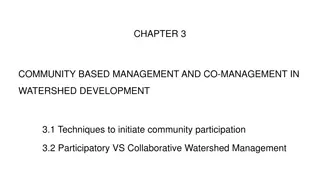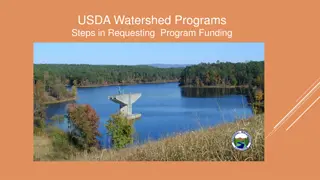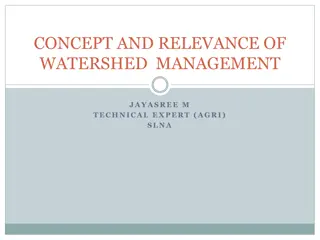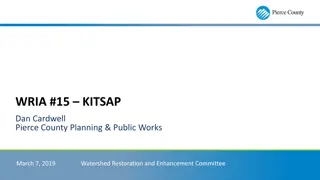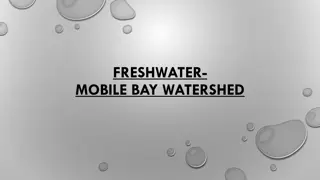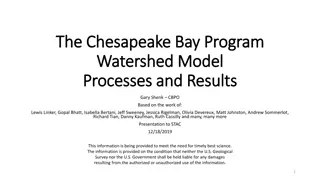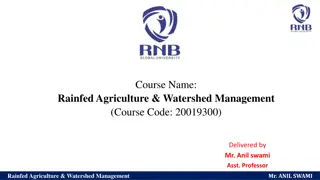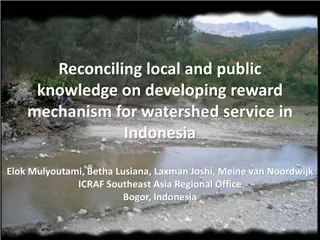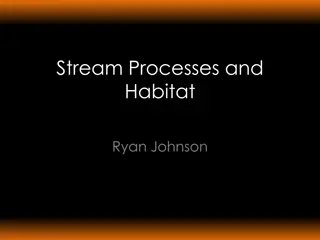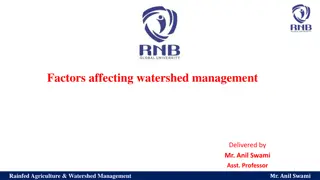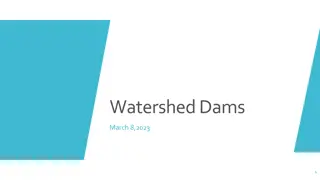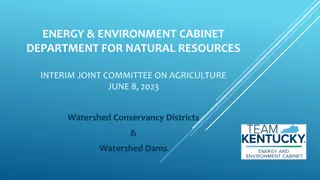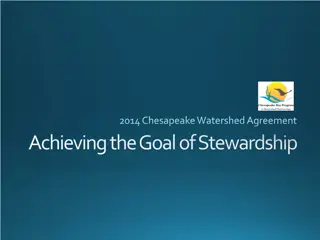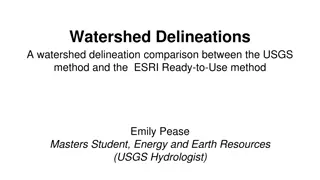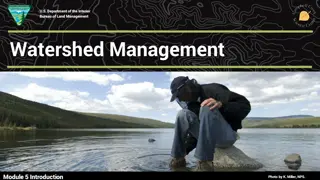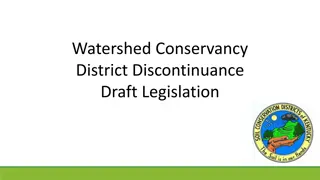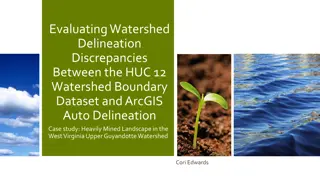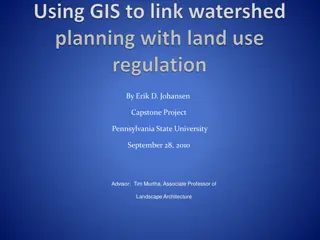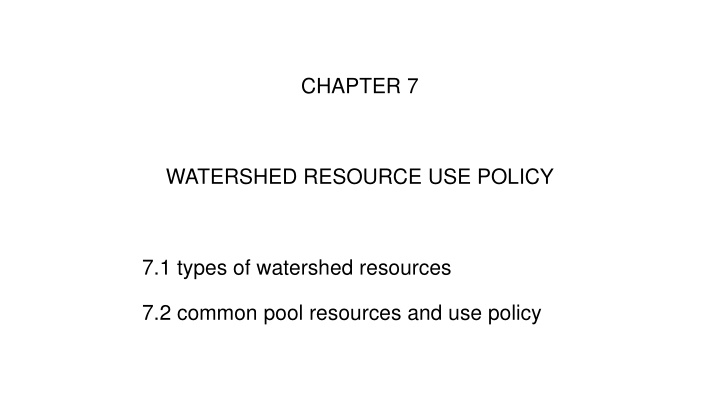
Watershed Resource Use Policy Overview
This content discusses types of watershed resources and common-pool resources in the context of management and sustainable use. It covers the challenges of coordinating resource supply and demand, potential CPR dilemmas, free-riding behavior, characteristics of CPRs, and governance regimes for managing these resources effectively.
Uploaded on | 0 Views
Download Presentation

Please find below an Image/Link to download the presentation.
The content on the website is provided AS IS for your information and personal use only. It may not be sold, licensed, or shared on other websites without obtaining consent from the author. If you encounter any issues during the download, it is possible that the publisher has removed the file from their server.
You are allowed to download the files provided on this website for personal or commercial use, subject to the condition that they are used lawfully. All files are the property of their respective owners.
The content on the website is provided AS IS for your information and personal use only. It may not be sold, licensed, or shared on other websites without obtaining consent from the author.
E N D
Presentation Transcript
CHAPTER 7 WATERSHED RESOURCE USE POLICY 7.1 types of watershed resources 7.2 common pool resources and use policy
types of watershed resources In the context of watershed management, common pool resources, ie, non- exclusive resources of which the rights of use are commonly held by users in a relatively well defined group (usually a community), include groundwater and surface water, fishery grazing lands, and forests. As effective government regulation is missing to ensure a sustainable management of these resources, households and communities somehow have to coordinate the supply and demand to avoid overexploitation
Common-Pool Resources Common pool resources (CPRs) to refer to resource systems regardless of the property rights involved. CPRs include natural and human constructed resources in which I. exclusion of beneficiaries through physical and institutional means is especially costly, and II. exploitation by one user reduces resource availability for others These two characteristics difficulty of exclusion and subtractability that create potential CPR dilemmas in which people following their own short-term interests produce outcomes that are not in anyone s long-term interest.
When resource users interact without the benefit of effective rules limiting access and defining rights and duties, substantial free-riding in two forms is likely: overuse without concern for the negative effects on others, and a lack of contributed resources for maintaining and improving the CPR itself. CPRs have traditionally included terrestrial and marine ecosystems that are simultaneously viewed as depletable and renewable. Characteristic of many resources is that use by one reduces the quantity or quality available to others, and that use by others adds negative attributes to a resource.
CPRs include earth-system components (such as groundwater basins or the atmosphere) as well as products of civilization such as irrigation systems Characteristics of CPRs affect the problems of devising governance regimes. oThese attributes include the size and carrying capacity of the resource system, othe measurability of the resource, othe temporal and spatial availability of resource flows, othe amount of storage in the system, whether resources move (like water, wildlife, and most fish) or are stationary (like trees and medicinal plants), ohow fast resources regenerate, and ohow various harvesting technologies affect patterns of regeneration
Institutions for Governing and Managing Common-Pool Resources Solving CPR problems involves two distinct elements: orestricting access and ocreating incentives (usually by assigning individual rights to, or shares of, the resource) for users to invest in the resource instead of overexploiting it. Four broad types of property rights have evolved or are designed in relation to CPRs When valuable CPRs are left to an open-access regime, degradation and potential destruction are the result. Both group-property and individual-property regimes are used to manage resources that grant individuals varying rights to access and use of a resource
Types of property-rights systems used to regulate common-pool resources Property rights Characteristics Open access Absence of enforced property rights Group property Resource rights held by a group of users who can exclude others Individual property Resource rights held by individuals (or firms) who can exclude others Government property Resource rights held by a government that can regulate or subsidize use
The primary difference between group property and individual property is the ease with which individual owners can buy or sell a share of a resource. Government property involves ownership by a national, regional, or local public agency that can forbid or allow use by individuals. Empirical studies show that no single type of property regime works efficiently, fairly, and sustainably in relation to all CPRs. It is possible, however, to identify design principles associated with robust institutions that have successfully governed CPRs for generations
The Evolution of Norms and Design of Rules The prediction that resource users are led inevitably to destroy CPRs is based on a model that assumes all individuals are selfish, norm-free, and maximizers of short-run results. However, predictions based on this model are not supported in field research in which individuals face a CPR problem and are able to communicate, sanction one another, or make new rules
Users of a CPR include I. those who always behave in a narrow, self-interested way and never cooperate in dilemma situations (free-riders); II. those who are unwilling to cooperate with others unless assured that they will not be exploited by free-riders; III. those who are willing to initiate mutual cooperation in the hopes that others will return their trust; and IV. perhaps a few genuine do-betters who always try to achieve higher returns for a group. Reciprocal/mutual cooperation can be established, sustain itself, and even grow if the proportion of those who always act in a narrow, self-interested manner is initially not too high
Evolved norms, however, are not always sufficeint to privent over exploitation. Participants or external authorities must deliberately devise rules that limit who can use a CPR, specify how much and when that use will be allowed, create and finance formal monitoring arrangements, and establish sanctions for nonconformance.
Property rights and collective action for watershed resources Across the world, efficient, equitable, and sustainable systems and institutions require varying combinations of state, collective action and individual rights or ownership. What Property rights mean? "an enforceable authority to undertake particular actions in a specific domain" (Commons, 1968) Property rights include particular bundles of rights or web of interests , not just full ownership Rights of use (access and withdrawal), and control (management, exclusion, and alienation) may be held by different claimants, even on the same resource,
Examples, when herders have rights to graze on fallow agricultural land, or When fishers, domestic water users and irrigators all draw from the same water source. Thus, systems of property rights need to accommodate multiple uses and users These overlapping uses can be a source of competition and conflict, However, these can also facilitate increased livelihood opportunities and environmental benefits for a broad range of people, especially the poor, than assigning simple ownership to a single right-holder. Property rights play a fundamental role in allocating both rights and responsibilities for resource management in a watershed
Where property rights are difficult to define or enforce, as for example for common pool resources, collective action is needed to achieve sustainable watershed resources (land, water, forest, pasture etc.) management While scarcity itself and access to markets may drive the emergence of collective action and/or property rights, the law and a set of institutions is needed to enable and administer property rights and to underpin collective action.
Need for both collective action and property rights Many sustainable watershed management technologies and practices are not adopted because of numerous potential constraints which include: suitability to particular local contexts, farmers knowledge of the practices, and costs relative to the returns to the farmers. Beside these factors, collective action is critical to the adoption of sustainable watershed management practices involving multiple farmers, and property rights and institutions are critical to ensure the adoption of sustainable watershed management technologies having long time horizons.
Role of collective action and property rights in natural resource management
As illustrated in the above figure, new varieties of annual crops can be adopted on a single plot that provides returns within a season. The technology can be adopted by a single farmer because of the short time horizon. These technologies are the simplest from an institutional standpoint. A single farmer can plant trees, without having to join others in the investment. Because of the long time horizon for trees, however, farmers without secure tenure may not have the incentive or even the authority to make such investments.
This can constrain the adoption of tree planting or soil fertility management, by households having insecure tenure and by women, who may not have recognized rights to the land, as a result of widowhood or divorce. IPM has relatively short payoff periods, but it operates at a larger spatial scale, some form of coordination is required. Most natural resource management approaches (e.g. irrigation, watershed development, rangelands, or forestry) have both large spatial scale and long time horizons. This means that both secure tenure and coordination institutions are required to apply the investments.
A precise identification of whether property rights or collective action are likely to be constraining or enabling factors in investments and technology choices. It can also provide guidance to the development and dissemination of technologies that are appropriate or the institutional context. Technologies that operate on a watershed management may be more appropriate where traditions of cooperation are strong. Those technologies that require an extended duration to produce benefits may realize greater success where tenures are long-term and reasonably secure Conversely, where many farmers have insecure tenure, technologies are required that offer significant short-term returns.
This empirical device helps identify the institutional implications of various technologies or approaches. Short-term technologies can be adopted in situations of low tenure security; Long-term technologies are unlikely to be adopted by people with low tenure security. Technologies that can be adopted on a single plot can be adopted without coordination, but the higher the spatial scale, the greater the need for some form of coordination
Coordination can be provided by the state, the market, or collective action (including both formal organizations and a range of customary organizations). For example, an irrigation system that serves many farmers can be operated by a government agency, by a farmers' group, or by an individual farmer who sells water to the others or many systems combine these. In general, one would expect that collective action institutions that tap into local knowledge have the greatest advantage at local levels, and state institutions have an advantage at higher levels, but both may be present and active at any given point.
Market institutions are most likely to operate when there is greater possibility of exclusion like in dealing with the transfer of land through rental and sales or from sales of water through pipes In contrast, activities that take large amounts of undifferentiated contributions (either cash or unskilled labor) are easier to organize through collective action where all users are directly involved in the management of the shared resource/equipment. Another well-known approach to identifying the likely roles of the state, markets, and collective action is to consider the degree of excludability and rivalry of a good or service.
Those with high excludability and high rivalry of consumption (subtractability) are generally private goods and allocated by markets. At the other extreme, those with low excludability and low rivalry are generally public goods, provided by the state. The most complex cases to manage are those with low excludability and high rivalry the common pool resources at which many natural resources fall into this case and that collective action is often called upon to play a major role. Because of the high costs of exclusion, it is difficult for individuals, but rivalry for consumption implies that the resource will be depleted unless there is careful management.
Eight design principles for successful management of collective resources has been identified by Ostrom (1990) 1. clearly defined boundaries (often an attribute of the resource itself), 2. proportionality between benefits and costs, 3. collective choice arrangements that allow users to make rules to govern the resource, 4. monitoring, 5. Graduated sanctions, 6. conflict resolution mechanisms, 7. minimal state recognition of resource users rights to organize, and 8. nested enterprises (local groups are nested within larger organizations to manage large-scale resources).
Where collective management of the resource is inadequate, or rights of common property are not recognized by the state and outsiders, open access and deterioration of the resource is likely to result. Customary right systems are often able to eliminate open access and provide security of tenure but when such systems break down, customary rights systems must be assisted to adapt and reinforced or individual rights must replace customary rights.
Joint land and water management Although land and water are often treated separately, often by different agencies, the resources are inseparably linked. Yet they are usually governed by different policies, rights and institutions. Even where the need of a joint approach appears to be obvious, as for example in river basin management, little integration has occurred. How to improve on the situation will require more research and policy experiments. the very limited progress in joint land and water management that has been made in a watershed management can be discuss as an example.
Addressing land and water degradation often requires a watershed approach, including problem identification, land-use planning, and institutions for coordinating between upstream and downstream areas. Integrated watershed or river basin management is also useful for runoff and to control point source and non-point source pollution, a key intervention area in most developed countries. Payment for Environmental Services (PES) has increased in importance as a mechanism for conservation of land and water resources and has most often been used in watersheds.
PES typically connects upstream land users, often farmers, with downstream water users. Upstream land users may be paid for, example, to maintain current forest areas or plant additional trees, for not grazing on sloping lands, or any other land activities that could affect water quality and quantity for downstream cities, reservoirs, industries, or tourism areas. Similar to other land and water improvements, formal or informal land and water property rights need to be established and recognized. PES functions better in small watersheds where there are few service providers and beneficiaries



